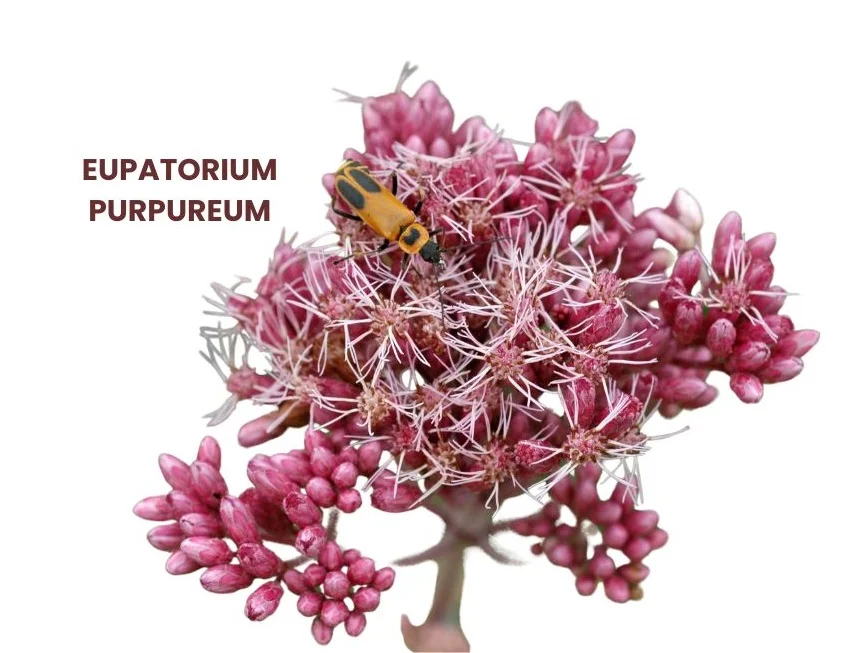Eupatorium purpureum, commonly known as Queen of the Meadow, is a perennial herb used in homeopathic medicine primarily for its effects on the urinary and reproductive systems.
This remedy is known to be beneficial for conditions such as albuminuria, diabetes, irritable bladder, enlarged prostate, and renal dropsy.

Table of Contents
ToggleDETAILED SOURCE INFORMATION
Scientific Classification
- Kingdom: Plantae
- Clade: Angiosperms
- Clade: Eudicots
- Order: Asterales
- Family: Asteraceae
- Genus: Eupatorium
- Species: E. purpureum
Origin
- Eupatorium purpureum is native to North America and is commonly found in wet meadows, ditches, and riverbanks.
- It grows well in moist, well-drained soil and is often cultivated for its attractive purplish-pink flower clusters.
Historical Facts
- Traditionally used by Native Americans for treating kidney and urinary disorders.
- Recognized for its diuretic properties and used to relieve fluid retention.
- The name “Queen of the Meadow” reflects its stately presence in wetland areas and its medicinal significance.
DRUG PATHOGENESIS
- Eupatorium purpureum acts primarily on the urinary tract, reproductive organs, and the back.
- It has a special affinity for the kidneys and bladder, helping alleviate symptoms associated with irritation and inflammation.
KEY CHARACTERISTICS
MIND
- Homesickness: A longing for home, often associated with emotional distress.
HEAD
- Left-sided headache with vertigo: Dizziness and pain predominantly on the left side.
- Pain from left shoulder to occiput: Discomfort extending from the shoulder to the back of the head.
- Sick headache: Begins in the morning, worsens in the afternoon and evening, and exacerbated by cold air.
URINARY
- Deep, dull pain in kidneys: Persistent ache in the kidney region.
- Burning in bladder and urethra on urinating: Sensation of burning during urination.
- Insufficient flow; milky urine: Reduced urine output, with a cloudy or milky appearance.
- Strangury: Painful and frequent urination.
- Haematuria: Presence of blood in the urine.
- Constant desire to urinate: Bladder feels persistently full and uncomfortable.
- Dysuria: Painful or difficult urination.
- Vesical irritability in women: Bladder irritation leading to frequent urination.
- Diabetes insipidus: A condition characterized by excessive thirst and urination.
BACK
- Weight and heaviness in loins and back: Sensation of heaviness and discomfort in the lower back.
FEMALE
- Pain around left ovary: Discomfort localized to the region of the left ovary.
- Threatened abortion: Risk of miscarriage.
- External genitals feel as though wet: Sensation of moisture or wetness in the genital area.
FEVER
- No thirst during chill, but much frontal ache: Headache predominates over thirst during feverish chills.
- Chill commences in back: Shivering begins in the back.
- Violent shaking with comparatively little coldness: Intense shivering despite a lack of severe cold.
- Bone-pains: Deep, aching pain in the bones.
MODALITIES
Worse
- Cold air
- Morning, afternoon, and evening
Better
- Warmth
- Rest
WHAT ARE MODALITIES IN HOMOEOPATHY?
RELATIONSHIP WITH OTHER DRUGS
Compare with
- Senecio: Used for urinary and reproductive disorders.
- Cannabis sativa: Useful for urinary issues and sexual disorders.
- Helonias: Effective for kidney and uterine conditions.
- Phosphoric acid: Addresses nervous exhaustion and urinary problems.
- Triticum: Known for treating urinary tract irritation.
- Epigea: Helps in kidney stone and urinary tract conditions.
DOSE
- Typically used in the first potency (1X to 6X) depending on the individual case and severity of symptoms.
Frequently Asked Questions
What conditions can Eupatorium purpureum treat?
- It is effective for kidney and urinary disorders, including albuminuria, diabetes, irritable bladder, enlarged prostate, and renal dropsy.
- It also addresses headaches, homesickness, and fever with bone pain.
How should Eupatorium purpureum be taken?
- It is usually taken in the first potency, and the dosage should be tailored to the individual’s specific symptoms and response to the remedy.
Can Eupatorium purpureum be used for both acute and chronic conditions?
- Yes, it can be used for both types of conditions, but it is important to consult a homeopathic practitioner for chronic or severe cases.
Glossary of Difficult Words
- Albuminuria: Presence of albumin (a type of protein) in the urine, often indicating kidney disease.
- Strangury: Painful and frequent urination.
- Haematuria: Blood in the urine.
- Dysuria: Painful or difficult urination.
- Vesical irritability: Irritation of the bladder causing frequent urination.
- Diabetes insipidus: A condition characterized by excessive thirst and the excretion of large amounts of urine.
- Erythema: Redness of the skin caused by increased blood flow.
- Oedema: Swelling caused by fluid accumulation in the tissues.
- Delirium: An acutely disturbed state of mind characterized by restlessness, illusions, and incoherence.
- Coma: A state of deep unconsciousness.
- Purgation: Cleansing or purifying, especially the bowels.
- Occiput: The back part of the head or skull.
